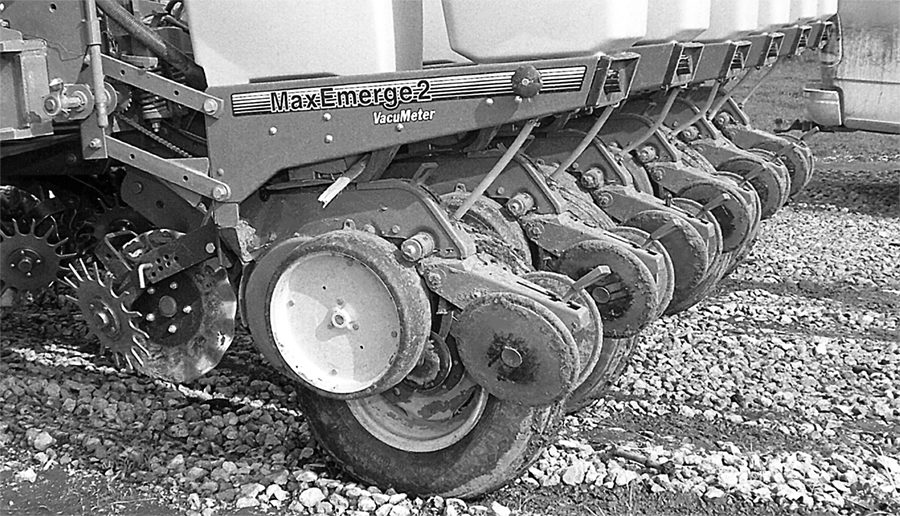High corn and soybean yields don’t happen by chance on Condon and Mark Schnepel’s farm in Carson, Iowa. The brothers use a four-step process of planning, on-farm researching, implementing and reviewing to manage their 1,000-acre no-till operation.
Their philosophy is to give new ideas a try “because you don’t know what works until you’ve done it,” says Condon. “It’s pretty easy to follow the same program every year, but if you always do the same thing you’re almost guaranteeing yourself the same results.”
Although they disagree on certain ideas, such as whether to apply anhydrous in the fall or spring, the Schnepels can answer each others’ questions through on-farm research plots.
Do On-Farm Trials
“That was really stressed at the National No-Tillage Conference,” says Condon, who was an attendee at the 1997 event in Des Moines.
“You have to use your farm as a test plot because that’s the only way you’re going to know if something works for you. You can’t rely on other people’s information and expect it to work for you.”
Some examples of test-plot studies the Schnepels have conducted include yield differences between Bt and non-Bt corn, row-width studies, fertility studies, how various down pressure levels affect plant populations and using different types of closing wheels.
However, the Schnepels have had difficulties determining if significant yield differences existed. The brothers hope to eliminate this problem with the addition of a yield monitor to their John Deere 9400 combine. They also considered equipping the combine with a Global Positioning System (GPS), but they decided against it.
While the brothers feel GPS would pinpoint problems, they aren’t sure the added expense would give clear-cut solutions.
“We decided to take this one step at a time,” says Mark. “Wet areas of fields will affect data collected, making it less meaningful this year as our soils are saturated in areas that have never been a problem before.”
Defined Partnership
When the brothers began no-tilling with a 16-acre corn field in 1984, they worked as a team doing whatever needed to be done. They still work as a team, but with more defined roles.
Mark does all the spraying and grain hauling in the fall. Condon is responsible for planting and running the combine. This makes it easier for them to make between-field comparisons because one person is consistently operating the same equipment.
No-Till Planter Payoff
If there’s one thing no-tillers can do to boost yields, Condon says it’s getting the planter adjusted correctly for planting during winter.
The Schnepels use a John Deere 1760 12-row, 30-inch no-till planter for corn. No-till planter attachments include Yetter residue managers, 13-wave coulters and J & S Innovations seed firming wheels.
“On the first day of planting, the planter is set to go,” says Condon. “But there will always be adjustments that need to be made in the field. Often this amounts to changing down pressure.
“I also watch for hairpinning of residue and adjust row cleaners so they are gently sweeping away trash from the row.”
Understandably, planting season is a rushed time. That’s the main reason the Schnepels upgraded from a six-row to 12-row planter. Sometimes rushing into something just isn’t worth it, however.
“Last year there was rain coming and I had a field to plant on a farm not previously rented,” Condon recalls. “I didn’t adjust the planter and set the residue cleaners lower and it really hurt the yield.”
Achieving enough down pressure to get good seed placement was enhanced by adding dirt to the insecticide boxes. The Schnepels needed more than 400 pounds of down pressure because the ground had not frozen deeply during the winter.
Fertility Studies
The Schnepels want to see if the yield monitor will show a yield difference where anhydrous was applied in the fall vs. the spring.
“This has always been a debate between us,” says Mark. “Condon applies anhydrous on bottom ground in the spring and I do hill ground in the fall. I think applying nitrogen in spring creates more compaction.”
No-Till Land Rentals
Mark adds that his son, Aaron, who is getting started in farming, rented some land this year.
“Renting is a whole different world,” says Mark. “We don’t rent a lot of land, but most of what we have rented has been from family members.
“You have to look at what you’re going to get out of that ground. Most cash rented land in this area is low in fertility. You can get such a boost out of tillage and a good fertilizer program during that first year.
“I can see why people wouldn’t no-till in that situation. My thinking is that no-till will pay off in the long run, but it makes you think twice when you might not have that land again next year.”







Post a comment
Report Abusive Comment